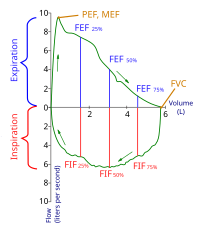
Photo from wikipedia
Echocardiographic parameters of diastolic function depend on cardiac loading conditions, which are altered by positive pressure ventilation. The direct effects of positive end-expiratory pressure (PEEP) on cardiac diastolic function are… Click to show full abstract
Echocardiographic parameters of diastolic function depend on cardiac loading conditions, which are altered by positive pressure ventilation. The direct effects of positive end-expiratory pressure (PEEP) on cardiac diastolic function are unknown. Twenty-five patients without apparent diastolic dysfunction undergoing coronary angiography were ventilated noninvasively at PEEPs of 0, 5, and 10 cmH2O (in randomized order). Echocardiographic diastolic assessment and pressure–volume-loop analysis from conductance catheters were compared. The time constant for pressure decay (τ) was modeled with exponential decay. End-diastolic and end-systolic pressure volume relationships (EDPVRs and ESPVRs, respectively) from temporary caval occlusion were analyzed with generalized linear mixed-effects and linear mixed models. Transmural pressures were calculated using esophageal balloons. τ values for intracavitary cardiac pressure increased with the PEEP (n = 25; no PEEP, 44 ± 5 ms; 5 cmH2O PEEP, 46 ± 6 ms; 10 cmH2O PEEP, 45 ± 6 ms; p < 0.001). This increase disappeared when corrected for transmural pressure and diastole length. The transmural EDPVR was unaffected by PEEP. The ESPVR increased slightly with PEEP. Echocardiographic mitral inflow parameters and tissue Doppler values decreased with PEEP [peak E wave (n = 25): no PEEP, 0.76 ± 0.13 m/s; 5 cmH2O PEEP, 0.74 ± 0.14 m/s; 10 cmH2O PEEP, 0.68 ± 0.13 m/s; p = 0.016; peak A wave (n = 24): no PEEP, 0.74 ± 0.12 m/s; 5 cmH2O PEEP, 0.7 ± 0.11 m/s; 10 cmH2O PEEP, 0.67 ± 0.15 m/s; p = 0.014; E’ septal (n = 24): no PEEP, 0.085 ± 0.016 m/s; 5 cmH2O PEEP, 0.08 ± 0.013 m/s; 10 cmH2O PEEP, 0.075 ± 0.012 m/s; p = 0.002]. PEEP does not affect active diastolic relaxation or passive ventricular filling properties. Dynamic echocardiographic filling parameters may reflect changing loading conditions rather than intrinsic diastolic function. PEEP may have slight positive inotropic effects. https://clinicaltrials.gov/ct2/show/NCT02267291, registered 17. October 2014.
Journal Title: Clinical Research in Cardiology
Year Published: 2022
Link to full text (if available)
Share on Social Media: Sign Up to like & get
recommendations!